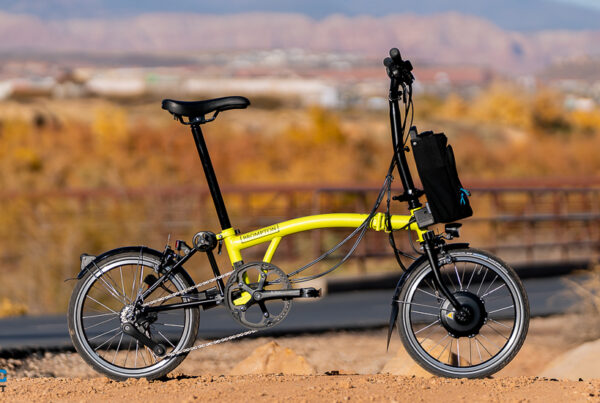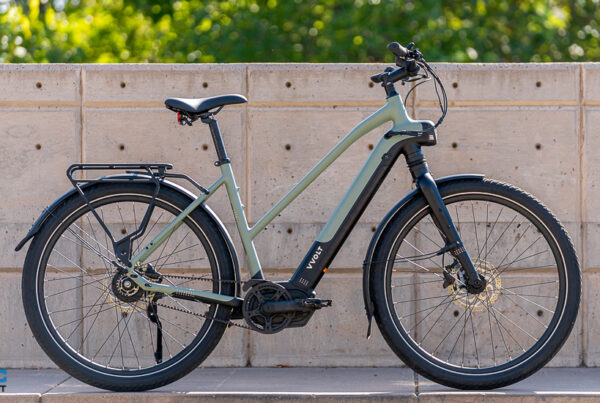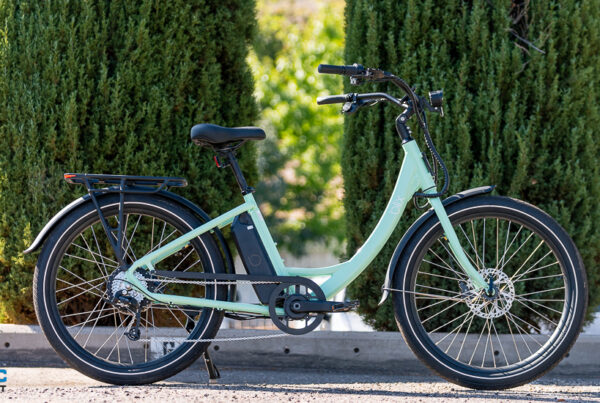Some links may be affiliate links. We may get paid if you buy something or take an action after clicking one of these.
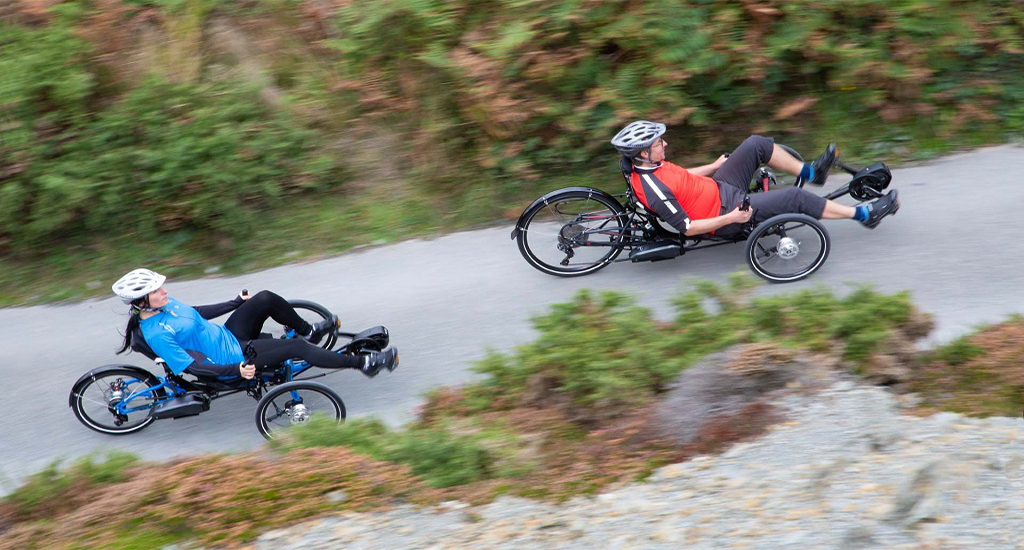
A recumbent bike or e-bike, as the name suggests, is one where you lay down in a seat rather than perch on a saddle. They come in 2, 3 and 4 wheeled versions. 3 wheelers, or trikes as they are more commonly known, are by far the most common design.
While they are a little more niche than the millions of traditional 2-wheeled bikes you’ll typically encounter on the road, they have a dedicated fan base that finds enjoyment and utility from their design.
The electric revolution hasn’t only given us some of the best electric bikes around, but they’ve led to innovation in the recumbent trike world as well.
I’ve test ridden several recumbent and electric recumbent machines and always enjoyed it – and always received loads of interest in the bike itself, mainly in the form of what is it and why would I want to ride one? So, if you want to know too, read on…
Comfort

Fancy cycling in real comfort? Why not try an electric recumbent? These models are from HP Velotechnik who have a wide network of dealers in Europe, US and Canada.
Ask any recumbent rider why they ride a recumbent and one of the main if not the main reason will be comfort. On a recumbent you get a reclining, comfortable seat that supports your back and spreads the weight over the whole of your posterior too. Being saddle sore should be a thing of the past. Some recumbent riders also say that they find there is less stress on the wrists and the neck (some models – but certainly not all – have a seat extended above the back of the head or at least a head support).
The longer you ride the more these comfort advantages come to the fore of course, making recumbents particularly suitable for long commutes and extended touring.
Enjoyment and Speed

Speed on the flat and downhill is a major plus point in recumbents favour. You can gain even more speed by adding a fairing, as on this HP Velotechnik model
A supine or recumbent, low down, laid down riding position means much less wind resistance. When riding on the flat or downhill and once up to speed, wind resistance accounts for around 70-90% of the pedal resistance and the faster you try and go the harder and harder it becomes as the wind resistance increases at a greater rate than your speed.
This is quite noticeable when you ride a recumbent – you accelerate beyond the 15-20mph range quite quickly and the lesser wind resistance means attaining higher speeds quicker on the flat and downhill.
Trikes also allow you to corner pretty fast – on a two-wheeler the speed of cornering is limited by how much are able to lean into the corner. The fact your weight is low down will also help counter the tendency of all trike designs (recumbent or otherwise) to tip, or at least experience wheel lift, on a very fast corner.
Great for Those With Physical Problems
If you have a balance problem or a physical problem that means balancing a two-wheeler is difficult or not possible then a recumbent trike could be your solution. Using a recumbent with one hand can also prove easier. Some companies can also provide adaptions for disabilities such as shifters operated by one hand only, shorter or longer frames and shorter or longer cranks and various frame modifications such as grab handles for easier getting on and off the bike. Recumbent manufacturer AZUB give some good examples here.
Here California’s Laid Back Cycles show you how grab handles work:
An added benefit – whether you have balance problems or not – is that 3 and 4 wheeled recumbent models are more stable at low speeds than 2 wheeled models.
Carry More, More Easily

Recumbents can often be fitted with two sets of pannier racks, underneath the rider and at the rear giving loads of carrying capacity – and the weight remains low down for stable handling, unlike on a diamond frame ‘upright’ design where the weight will be higher up.
Unlike with heavily loaded uprights there is no chance of a 3 wheeler toppling over.
The Perfect Bikes for Electric Assist

Electric recumbents mean the traditional disadvantage of recumbent cycling – lack of speed up hills – can easily be overcome with motor power.
Hillclimbing can be a weak point for non-electric recumbents – it’s not so much that you can’t climb steep hills (low gears should let you do that) but rather that your body is not in a position to utilise the upper body and climb hard, as you can on a traditional diamond frame bike – be it bike or e-bike. By adding electric assist you are able to get far more power from leg action alone and so more speed up the hills on a recumbent design.
Cons
In addition to weak hillclimbing (when not electric assisted) recumbents do have some other disadvantages to bear in mind, which may or may not be important depending on your particular cycling needs.
Just looking at recumbents makes the three main downsides pretty clear; their size means less maneuverability (difficulty up and over curbs in particular) and more storage space is required, whilst being low down if you have to ride very close to very heavy traffic it can feel unsafe (in practice I find motor traffic is very wary of recumbent riders and give you more space – most likely because they are unsure exactly what kind of vehicle you are!).
There is also the fact they tend to cost more than conventional bikes of a similar spec.
Riding a 2 wheeled recumbent is a different skill to riding a regular bike, though not necessarily any harder once you have had plenty of practice.
Some Leading Designs of Electric Recumbents
Design and Brand Overview
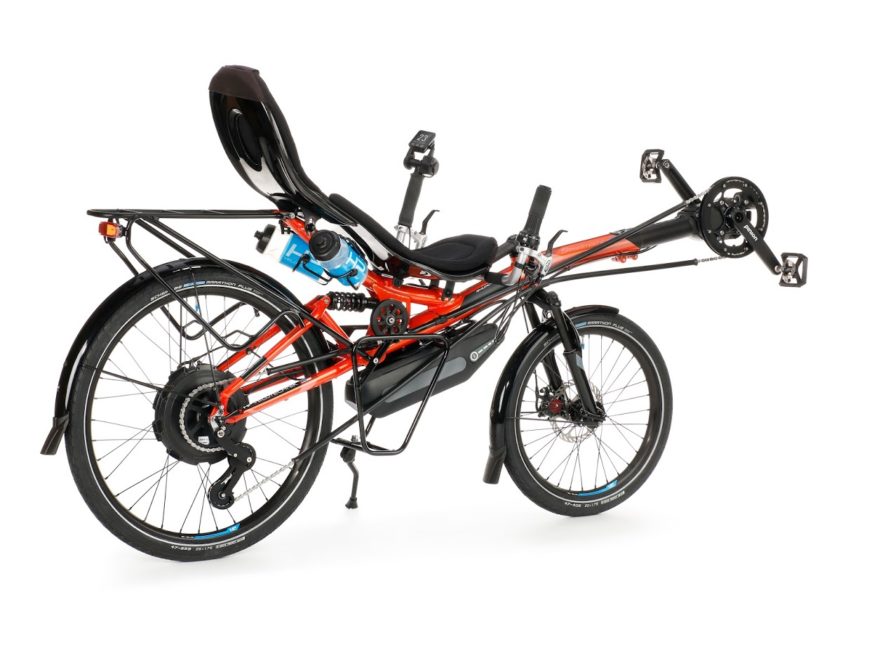
This 2 wheeled e-recumbent from HP Velotechnik features full suspension, internal gearing around the pedal axle and a rear hub motor assist system
2 wheel recumbents are relatively rare and electric-assist even rarer. Recumbent trike designs come in two main types, with 2 wheels at the front (tadpoles) or 2 at the back (deltas). For an outline of the sometimes subtle pros and cons of each design check out this Queensland Recumbent Trikes article.
Here, in no particular order are some leading brands of electric assist recumbents:

The Ecat trike uses the Bosch Active Line Plus mid drive
Impressively it comes both as ready-fitted or as retrofittable to an existing non-electric Catrike. For more detail check out the helpful video from Utah Trikes:

ICE’s Full Fat electric version is a pretty unusual design
UK based ICE has a number of designs, including folding designs and a fat trike, which the choice of two Shimano Steps system (E8000 and E6100) is available on.

Like ICE, this German manufacturer has an impressive worldwide chain of dealers and a great range of designs. In addition to Shimano Steps mid drives they also offer the Neodrives hub system.

Terratrike’s Rambler EVO model uses the industry-leading Bosch mid-drive system.

This is a very rare design allowing one upright rider at the back and a recumbent rider at the front. The recumbent rider’s pedal reach can be adjusted to accommodate both children or adults.
Outriders are fast and they will venture off-road and look superb fun!
Stay tuned for more e-bike news and reviews and thanks for reading!
-Rich
Reader Interactions
![]()
Source link






